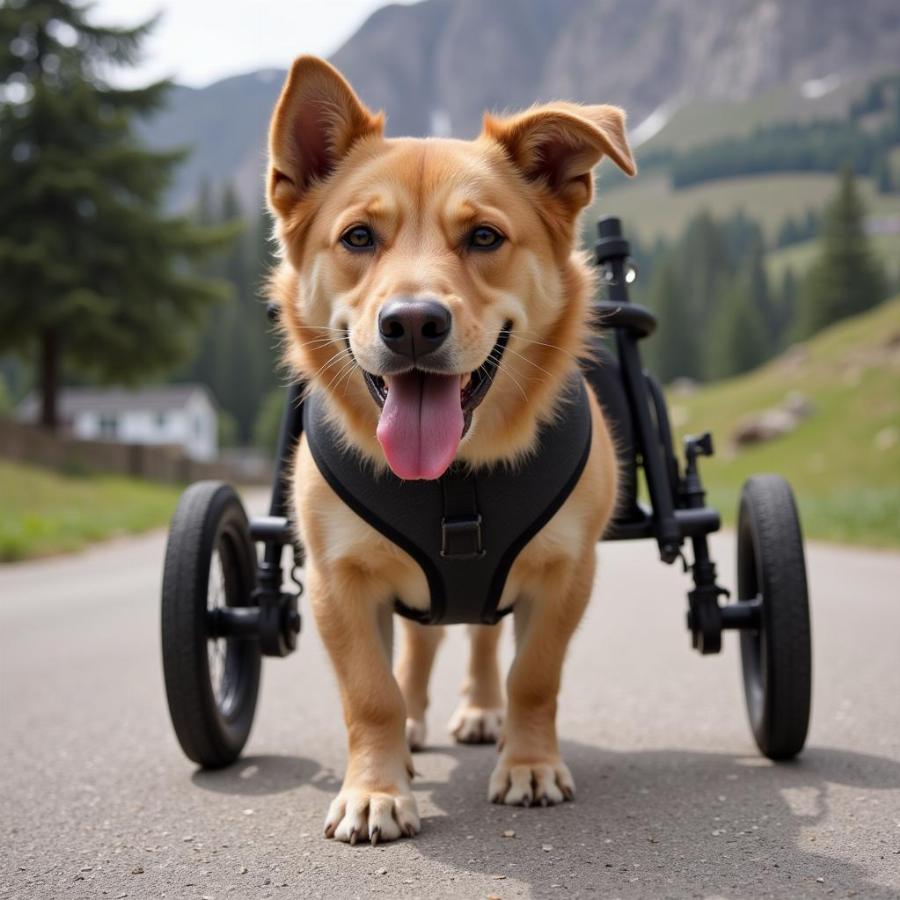Degenerative myelopathy (DM) is a progressive, debilitating disease of the canine spinal cord. Often compared to ALS (Amyotrophic Lateralateral Sclerosis) in humans, DM affects a dog’s ability to walk, eventually leading to paralysis. This article provides a comprehensive guide to understanding DM in dogs, covering symptoms, diagnosis, management, and support for affected dogs and their owners.
What is Degenerative Myelopathy in Dogs?
Degenerative myelopathy is a neurodegenerative disease, meaning it progressively damages the nervous system. It specifically affects the white matter of the spinal cord, disrupting the communication between the brain and the dog’s hind limbs. This leads to a gradual loss of coordination, muscle weakness, and eventually, paralysis. While heartbreaking, understanding the disease process can help owners provide the best possible care for their beloved companions. DM most commonly affects older dogs, typically starting around eight years of age. Certain breeds, such as German Shepherds, Boxers, and Corgis, are predisposed to the condition.
Recognizing the Symptoms of DM
Early signs of DM can be subtle and easily overlooked. Owners might notice their dog wobbling in their hind legs, especially after exercise. They may also drag their paws, wearing down the nails. As the disease progresses, the weakness becomes more pronounced. Dogs may struggle to stand, climb stairs, or even control their bladder and bowels. It’s crucial to consult a veterinarian if you notice any of these symptoms, as early diagnosis can help manage the disease’s progression and improve your dog’s quality of life.
Diagnosing Degenerative Myelopathy
Diagnosing DM can be challenging as the symptoms can mimic other conditions. Your veterinarian will likely conduct a thorough neurological examination and may recommend further tests, including blood work, X-rays, and MRI scans, to rule out other potential causes. A DNA test can identify a genetic mutation associated with an increased risk of DM, but it’s important to note that having the mutation doesn’t guarantee the dog will develop the disease.
Managing Degenerative Myelopathy: Providing Comfort and Support
While there is no cure for DM, there are ways to manage the disease and improve a dog’s quality of life. Physical therapy, including exercises and hydrotherapy, can help maintain muscle strength and mobility. Assistive devices, like dog wheelchair for large dogs, can provide support and allow dogs to continue enjoying walks and other activities. Maintaining a clean and comfortable living environment is also essential, as incontinent dogs are susceptible to skin infections. You might consider using a dog folding ramp to help your dog navigate stairs and furniture. Knowing how long does a german shepherd dog live can help you plan for your dog’s care, especially if they are diagnosed with DM.
What is the prognosis for a dog with DM?
Sadly, DM is a progressive disease with no known cure. The time from diagnosis to complete paralysis can vary, but it typically ranges from six months to three years. It is important to understand that the disease itself is not painful, but the associated immobility can lead to discomfort. Degenerative myelopathy in dogs when to euthanize is a difficult but sometimes necessary decision. Open communication with your veterinarian and considering your dog’s quality of life are crucial in making this decision. Loss of mobility can also lead to issues such as fecal incontinence in dogs, which requires careful management.
 Dog with Degenerative Myelopathy Using Assistive Devices
Dog with Degenerative Myelopathy Using Assistive Devices
Living with a Dog with DM: Tips for Owners
Caring for a dog with DM requires patience, dedication, and a lot of love. Establishing a routine for exercise, physical therapy, and hygiene can help maintain your dog’s comfort and well-being. Be prepared for changes in your dog’s mobility and adjust their environment accordingly. Remember to provide plenty of emotional support and affection throughout the disease progression.
Conclusion
Degenerative myelopathy is a challenging diagnosis, but with understanding and proactive management, you can provide your dog with a loving and supportive environment. While there is no cure, focusing on comfort, mobility, and quality of life can make a significant difference for both you and your beloved companion. Early diagnosis and intervention are key to managing this devastating disease.
FAQ
- Is DM painful for dogs? No, DM itself is not painful, but the associated loss of mobility can cause discomfort.
- How is DM diagnosed? Diagnosis involves a combination of neurological exams, blood tests, and imaging to rule out other conditions. A DNA test can identify a genetic predisposition.
- Can DM be cured? Unfortunately, there is no known cure for DM.
- How can I help my dog with DM? Focus on providing physical therapy, assistive devices, a supportive environment, and lots of love.
- What is the prognosis for dogs with DM? The disease is progressive, and most dogs will experience paralysis within six months to three years of diagnosis.
- When should I consider euthanasia? This is a personal decision best made in consultation with your veterinarian, considering your dog’s quality of life.
- Are there support groups for owners of dogs with DM? Yes, there are online communities and support groups that can provide valuable information and emotional support.
More Questions?
If you have more questions or need further assistance, please explore our other articles related to dog health and care.
Beaut Dogs: Your Trusted Source for Dog Information
Beaut Dogs is your one-stop resource for all things dog-related. We offer expert advice and comprehensive guides on everything from breed selection to health care, nutrition, and training. When you need support, don’t hesitate to contact us via Email: [email protected] to receive detailed and accurate answers from Beaut Dogs. Visit us at https://beautdogs.com to discover the wonderful world of dogs and learn how to care for them best!